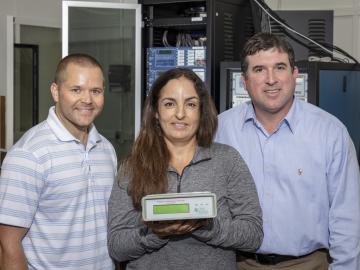
Filter News
Area of Research
- Biology and Environment (3)
- Computer Science (1)
- Energy Science (15)
- Fusion and Fission (4)
- Fusion Energy (5)
- Materials (5)
- National Security (3)
- Neutron Science (1)
- Nuclear Science and Technology (13)
- Nuclear Systems Modeling, Simulation and Validation (1)
- Quantum information Science (2)
- Supercomputing (13)
News Type
News Topics
- (-) Advanced Reactors (10)
- (-) Big Data (9)
- (-) Clean Water (3)
- (-) Composites (1)
- (-) Fusion (14)
- (-) Grid (9)
- (-) Machine Learning (5)
- (-) Mercury (2)
- (-) Molten Salt (5)
- (-) Quantum Science (6)
- 3-D Printing/Advanced Manufacturing (15)
- Artificial Intelligence (6)
- Bioenergy (7)
- Biology (5)
- Biomedical (21)
- Biotechnology (1)
- Chemical Sciences (2)
- Computer Science (31)
- Coronavirus (16)
- Critical Materials (1)
- Cybersecurity (4)
- Energy Storage (16)
- Environment (18)
- Exascale Computing (2)
- Frontier (1)
- High-Performance Computing (1)
- Isotopes (8)
- Materials Science (24)
- Mathematics (2)
- Microscopy (7)
- Nanotechnology (9)
- Neutron Science (23)
- Nuclear Energy (28)
- Physics (10)
- Polymers (7)
- Security (5)
- Space Exploration (3)
- Summit (10)
- Transportation (15)
Media Contacts

A team from the ORNL has conducted a series of experiments to gain a better understanding of quantum mechanics and pursue advances in quantum networking and quantum computing, which could lead to practical applications in cybersecurity and other areas.

Nuclear scientists at Oak Ridge National Laboratory have established a Nuclear Quality Assurance-1 program for a software product designed to simulate today’s commercial nuclear reactors – removing a significant barrier for industry adoption of the technology.

To better determine the potential energy cost savings among connected homes, researchers at Oak Ridge National Laboratory developed a computer simulation to more accurately compare energy use on similar weather days.

Researchers across the scientific spectrum crave data, as it is essential to understanding the natural world and, by extension, accelerating scientific progress.

Scientists from Oak Ridge National Laboratory performed a corrosion test in a neutron radiation field to support the continued development of molten salt reactors.

Carbon fiber composites—lightweight and strong—are great structural materials for automobiles, aircraft and other transportation vehicles. They consist of a polymer matrix, such as epoxy, into which reinforcing carbon fibers have been embedded. Because of differences in the mecha...

As Puerto Rico works to restore and modernize its power grid after last year’s devastating hurricane season, researchers at Oak Ridge National Laboratory have stepped up to provide unique analysis, sensing and modeling tools to better inform decisions.

Oak Ridge National Laboratory scientists have devised a method to control the heating and cooling systems of a large network of buildings for power grid stability—all while ensuring the comfort of occupants.

Experts focused on the future of nuclear technology will gather at Oak Ridge National Laboratory for the fourth annual Molten Salt Reactor Workshop on October 3–4.

Biologists from Oak Ridge National Laboratory and the Smithsonian Environmental Research Center have confirmed that microorganisms called methanogens can transform mercury into the neurotoxin methylmercury with varying efficiency across species.


